Vanity Fair (UK magazine)
_cover.jpg)
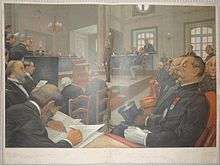
The second Vanity Fair was a British weekly magazine published from 1868 to 1914.
History
Subtitled "A Weekly Show of Political, Social and Literary Wares", it was founded by Thomas Gibson Bowles, who aimed to expose the contemporary vanities of Victorian society. The first issue appeared in London on 7 November 1868. It offered its readership articles on fashion, current events, the theatre, books, social events and the latest scandals, together with serial fiction, word games and other trivia.
Bowles wrote much of the magazine himself under various pseudonyms, such as "Jehu Junior", but contributors included Lewis Carroll, Arthur Hervey, Willie Wilde, P. G. Wodehouse, Jessie Pope and Bertram Fletcher Robinson (who was editor from June 1904 to October 1906).[1]
Thomas Allinson bought the magazine in 1911 from Frank Harris, by which time it was failing financially. He failed to revive it and the final issue of Vanity Fair appeared on 5 February 1914, after which it was merged into Hearth and Home.
Caricatures
A full-page, colour lithograph of a contemporary celebrity or dignitary appeared in most issues, and it is for these caricatures that Vanity Fair is best known then[2] and today.[3] Subjects included artists, athletes, royalty, statesmen, scientists, authors, actors, soldiers, religious personalities, business people and scholars. More than two thousand of these images appeared, and they are considered the chief cultural legacy of the magazine, forming a pictorial record of the period. They were produced by an international group of artists, including Max Beerbohm, Sir Leslie Ward (who signed his work "Spy" and "Drawl"), the Italians Carlo Pellegrini ("Singe" and "Ape"), Melchiorre Delfico ("Delfico"), Liborio Prosperi ("Lib"), the Florentine artist and critic Adriano Cecioni, the French artist James Jacques Tissot (Coïdé), and the American Thomas Nast.[4]
Image gallery
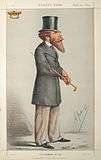 The Duke of Abercorn by Carlo Pellegrini in 25 September 1869 issue
The Duke of Abercorn by Carlo Pellegrini in 25 September 1869 issue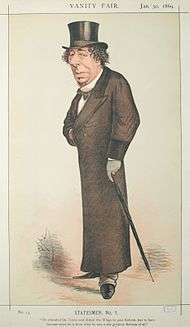 Benjamin Disraeli by Carlo Pellegrini in 30 January 1869 issue
Benjamin Disraeli by Carlo Pellegrini in 30 January 1869 issue Mansur Ali Khan of Bengal by "Atn" Alfred Thompson in 16 April 1870 issue
Mansur Ali Khan of Bengal by "Atn" Alfred Thompson in 16 April 1870 issue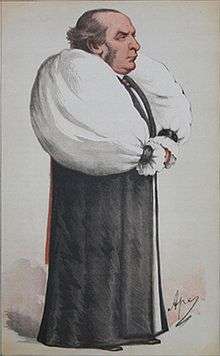 William Thomson, Archbishop of York by Carlo Pellegrini in 24 June 1871 issue
William Thomson, Archbishop of York by Carlo Pellegrini in 24 June 1871 issue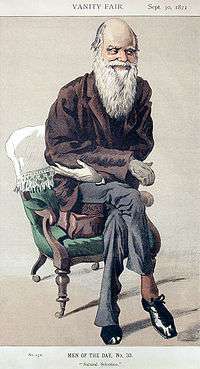 Charles Darwin by James Tissot in 30 September 1871 issue
Charles Darwin by James Tissot in 30 September 1871 issue- Samuel Mure Fergusson by Spy in 18 June 1903 issue
 Alexandre Dumas, fils by Théobald Chartran in 27 December 1879 issue
Alexandre Dumas, fils by Théobald Chartran in 27 December 1879 issue Maj. E.H. Egerton by Liborio Prosperi in 24 August 1889 issue
Maj. E.H. Egerton by Liborio Prosperi in 24 August 1889 issue.jpg) Baron Alfred Emmott by "WHO" in 19 October 1910 issue
Baron Alfred Emmott by "WHO" in 19 October 1910 issue
 Railway promoter Archer Baker by Luke Fildes in 13 January 1910 issue
Railway promoter Archer Baker by Luke Fildes in 13 January 1910 issue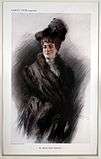 Queen Alexandra (unsigned) in 7 June 1911 issue
Queen Alexandra (unsigned) in 7 June 1911 issue
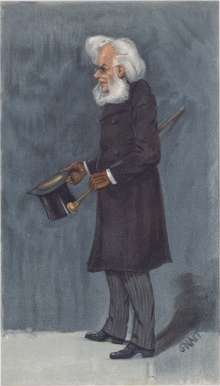 Henrik Ibsen by "Snapp" in 12 December 1901 issue
Henrik Ibsen by "Snapp" in 12 December 1901 issue_from_Vanity_Fair_Issue_812%2C_April_1884..jpg) Oscar Wilde by Carlo Pellegrini in Issue 812, April 1884
Oscar Wilde by Carlo Pellegrini in Issue 812, April 1884 Horace Hutchinson by Spy in 19 July 1890 issue
Horace Hutchinson by Spy in 19 July 1890 issue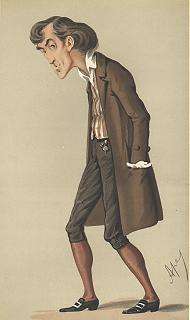 Caricature of Henry Irving in the melodrama The Bells, in December 19, 1874
Caricature of Henry Irving in the melodrama The Bells, in December 19, 1874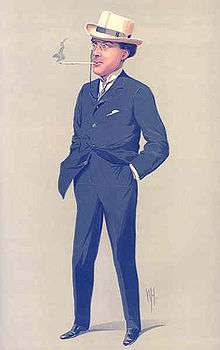 Caricature of Laurence Sydney Brodribb Irving in December 18, 1912
Caricature of Laurence Sydney Brodribb Irving in December 18, 1912
See also
- List of Vanity Fair artists
- List of Vanity Fair caricatures
- The Rowers of Vanity Fair Wikibook gives a history of the magazine with focus on sportsmen
References
- ↑ Spiring, Paul R (2009). The World of Vanity Fair by Bertram Fletcher Robinson. London: MX Publishing. ISBN 1-904312-53-5.
- ↑ "Literary Gossip". The Week : a Canadian journal of politics, literature, science and arts. 1 (18): 286. 3 April 1884. Retrieved 30 April 2013.
- ↑ Matthews, Roy T.; Mellini, Peter (1982). In 'Vanity Fair'. U. of California Press.
- ↑ "National Portrait Gallery - Set - Vanity Fair cartoons". npg.org.uk.
External links
| Wikimedia Commons has media related to Vanity Fair (British magazine 1868-1914). |
- Vanity fair cartoons, UK: National Portrait Gallery.